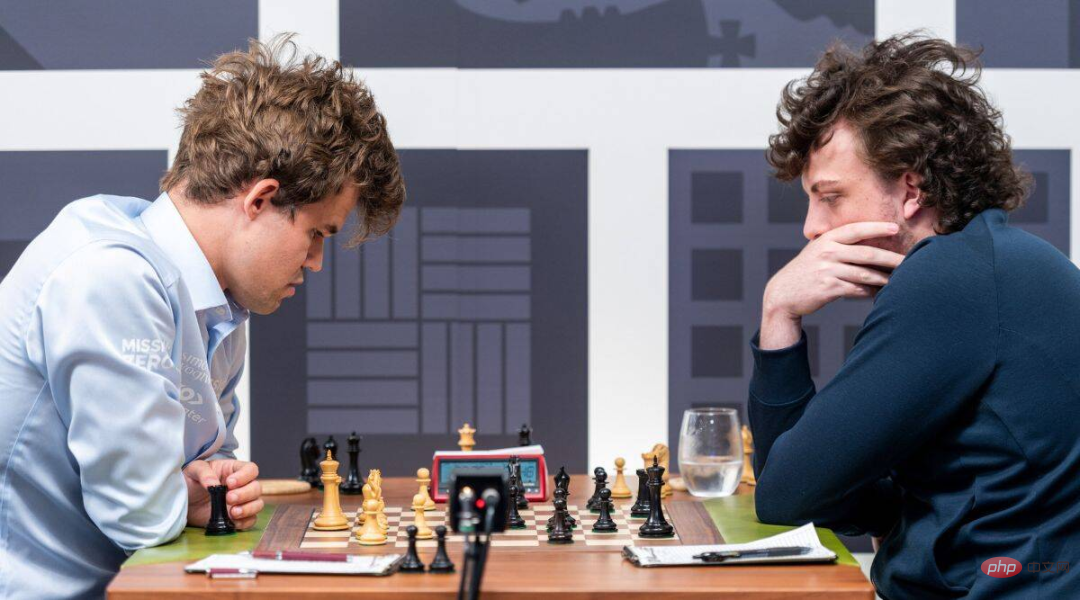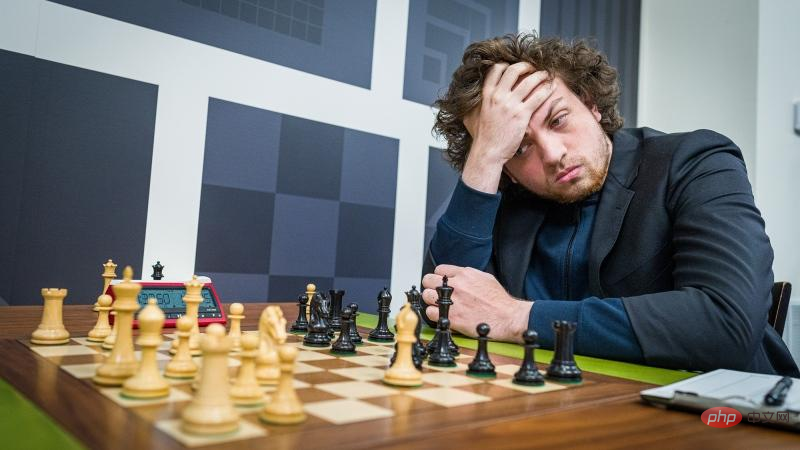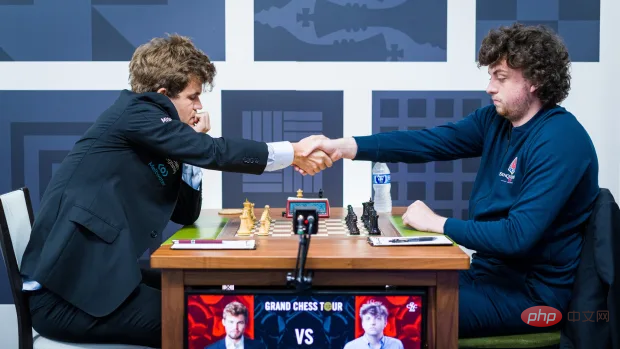 Technology peripherals
Technology peripherals
 AI
AI
 A 19-year-old American boy defeated the world chess champion and was accused of using AI to cheat!
A 19-year-old American boy defeated the world chess champion and was accused of using AI to cheat!
A 19-year-old American boy defeated the world chess champion and was accused of using AI to cheat!
Produced by Big Data Digest
Author: Caleb
A chess match in early October made 19-year-old Hans Niemann famous.
I believe everyone still remembers that this game also allowed Niemann to directly break the 53-game "undefeated Western Conference" record of Magnus Carlsen, who had been ranked number one in the world for many years.
Yes, in everyone’s eyes, this was originally a game without any suspense.
Subsequently, everyone began to suspect that Niemann cheated in the game.
After all, this is not his first time. Niemann also personally admitted that he had cheated in two games. He explained that this was because he really wanted to compete with top players, so he saw cheating as a shortcut. This was "the biggest mistake of his life." I also feel "ashamed" of this.

Okay, this is it, it seems that the dust has settled.
But there is another question, how did Niemann cheat?
AI is definitely the first thing that comes to mind. Now there are two ways to detect AI cheating. One is to rely on the intuition of top chess players; the other is to use AI to defeat AI. It is to use AI to detect the similarity between the questioned player's next game ideas and the AI.
However, none of these methods can give a 100% certain conclusion. In other words, even if Niemann did cheat, it is still unclear how he cheated, and corresponding punishment cannot be imposed.
#What is going on?
#We are back in this game again.
In fact, as early as September, discussions about Niemann’s rapid rise in rankings had already circulated. In 2021, the 17-year-old won the title of grandmaster, the highest level awarded by the World Chess Federation, and Niemann also entered the ranks of the 100 best chess players in the world.
On September 4, when Niemann played against Carlsen, everyone just regarded these rumors as a joke. After all, Carlsen has dominated the chess field for ten years and is rated by many as the best chess player of all time; on the other hand, Niemann, as a substitute, is the lowest-ranked player in the competition.
At the same time, judging from Niemann's promotion path, he is not considered to be the top, but he can also turn the situation around in many defeats and turn defeat into victory. Overall, Niemann's overall performance is average.
But in the last game, Niemann defeated Carlsen and caused an uproar.

Carlsen also felt that something strange was happening, so he withdrew from the game.
What was even more unexpected was that shortly before the first glass of wine was poured out during the award ceremony within a few hours, it was reported that Niemann had complained about Carlsen and the co-defendants. People filed a $100 million defamation lawsuit.
This is unprecedented. As chess YouTuber Levy Rozman said: "This may be the most shocking development the chess world has ever seen."
No one can blame cheating The final verdict
While it may seem like an accusation against chess players, the scandal also touches on a more general issue, which is the impact of AI on the highest levels of human intellectual expertise. Destructive effects.
This also makes chess sound a wake-up call for other artistic pursuits once thought to be uniquely human, including writing and creation. Regarding the philosophical issues of authenticity and fairness, Frank Pasquale, a professor at Brooklyn Law School, said: “If one day we are not sure whether we are facing a computer or a human, this will cause a lot of anxiety, uneasiness and frustration. ”
Tensions have raged in the chess world for decades since computers first surpassed human players.
Early chess programs also required large computers. In 1987, it cost $80,000 worth of computing time to play a game of chess on one program. Nowadays anyone can access it for free from anywhere on their mobile phone or laptop. These are transformative evolutions, revealing strategies never thought before by humans and giving players a deeper understanding of the game. The Internet and AI have also democratized the process of pursuing excellence.
But technology is a double-edged sword. AI is also beginning to distort the game's competitive dynamics in destructive ways. In online chess tournaments, for example, players must play in front of a camera, but it's not difficult to keep computers out of sight.

Despite this, no one can say for sure that Niemann cheated. Judging from past examples, cheaters usually use mobile phones or devices hidden in shoes to receive signals when going to the toilet, but they are always discovered in time.
There was a speculation from a co-conspirator in the audience that the signal was given by moving around the competition hall. However, the competition has already implemented safeguards, such as electronic scanning of players, and no one believes that Niemann can circumvent these tests.
On the contrary, many people worry that Niemann may have found some new, undiscovered methods.
In response, Niemann himself admitted that he cheated in online competitions, once at the age of 12 when a friend helped him, and again at the age of 16 on an electronic device with the help of. But he said he has never cheated in a live game as an adult.
Even if you can't prove your innocence, you can't clear your "crimes"
The matter is not over yet.
In the subsequent game between the two, Carlsen took one step and left. Chess.com, the largest online chess platform, came out in support of Carlsen, writing in a report that "Niemann may have cheated online more often than his public statements indicate" and therefore, "we will not invite him Join us at one of our major upcoming online events.”

Niemann said: "I will not back down, no matter how much pressure I am under, I will Play my best here."
This also caused the chess world to begin to divide. Some say it is unfair for the most powerful man in the chess world to make such serious accusations against a young player without evidence. Others say it's time someone spoke out about the wider issue of cheating.
Generally speaking, there are two ways to detect cheating when there is no conclusive physical evidence, such as a transmitter hidden in a shoe. The first is intuition, where the expert feels that the player is not making the right move. "You know how the human mind works, people tend to make decisions in a certain way." Computers use different calculation processes and can come to very different conclusions. But this is an ability that only top players have, and is difficult to prove.
The second method is to perform algorithmic analysis of the chessboard. Computer scientist Ken Regan, considered the world's foremost expert on chess cheating, has developed a statistical method to use chess engines to measure the utility of each move, that is, how effective they are in bringing the player closer to victory. thereby detecting cheating patterns. This is similar to the method used by securities regulators to detect potential insider trading, which also failed to convince everyone.
The worst-case scenario, and what many fear is most likely to happen, is that there is no convincing evidence that Niemann cheated, but he still can't clear his name. If Niemann's lawsuit is successful, it could salvage his image.
The threat to competitive chess lies in the unknowability of what they might do, rather than the detriment of any one act. Such disruptions are likely to become more common as so-called synthetic expertise spreads, said Ron Fulbright, an informatics professor at the University of South Carolina Upstate. With the advent of Dall-E, which can produce detailed illustrations from a handful of prompt words, and GPT-3, which can spout detailed, understandable text, artists and writers are confronting what once was The astonishing possibility is that their expertise can also be automated.
“We will eventually have millions of synthetic experts in almost every field humans touch, whether it’s chess or law, or landscaping or plumbing. Once that happens, what will become the real expert?"
At a party held after the chess championship awards ceremony, Niemann strode into the room wearing a floral shirt, Putting the interview request aside, I sat down at a chess board near the dance floor and played bullet chess. — He doesn’t look like the center of controversy, but like an ordinary teenager attending a party.
This may be one thing that superhuman artificial intelligence can never do: treat games as fun.
Related reports:
https://www.bloomberg.com/news/articles/2022-11-11/carlson-niemann-chess-scandal-latest -chapter-in-ai-evolution?srnd=businessweek-v2&leadSource=uverify wall
The above is the detailed content of A 19-year-old American boy defeated the world chess champion and was accused of using AI to cheat!. For more information, please follow other related articles on the PHP Chinese website!

Hot AI Tools

Undresser.AI Undress
AI-powered app for creating realistic nude photos

AI Clothes Remover
Online AI tool for removing clothes from photos.

Undress AI Tool
Undress images for free

Clothoff.io
AI clothes remover

Video Face Swap
Swap faces in any video effortlessly with our completely free AI face swap tool!

Hot Article

Hot Tools

Notepad++7.3.1
Easy-to-use and free code editor

SublimeText3 Chinese version
Chinese version, very easy to use

Zend Studio 13.0.1
Powerful PHP integrated development environment

Dreamweaver CS6
Visual web development tools

SublimeText3 Mac version
God-level code editing software (SublimeText3)

Hot Topics
 1666
1666
 14
14
 1425
1425
 52
52
 1328
1328
 25
25
 1273
1273
 29
29
 1253
1253
 24
24
 How to use the chrono library in C?
Apr 28, 2025 pm 10:18 PM
How to use the chrono library in C?
Apr 28, 2025 pm 10:18 PM
Using the chrono library in C can allow you to control time and time intervals more accurately. Let's explore the charm of this library. C's chrono library is part of the standard library, which provides a modern way to deal with time and time intervals. For programmers who have suffered from time.h and ctime, chrono is undoubtedly a boon. It not only improves the readability and maintainability of the code, but also provides higher accuracy and flexibility. Let's start with the basics. The chrono library mainly includes the following key components: std::chrono::system_clock: represents the system clock, used to obtain the current time. std::chron
 How to understand DMA operations in C?
Apr 28, 2025 pm 10:09 PM
How to understand DMA operations in C?
Apr 28, 2025 pm 10:09 PM
DMA in C refers to DirectMemoryAccess, a direct memory access technology, allowing hardware devices to directly transmit data to memory without CPU intervention. 1) DMA operation is highly dependent on hardware devices and drivers, and the implementation method varies from system to system. 2) Direct access to memory may bring security risks, and the correctness and security of the code must be ensured. 3) DMA can improve performance, but improper use may lead to degradation of system performance. Through practice and learning, we can master the skills of using DMA and maximize its effectiveness in scenarios such as high-speed data transmission and real-time signal processing.
 How to handle high DPI display in C?
Apr 28, 2025 pm 09:57 PM
How to handle high DPI display in C?
Apr 28, 2025 pm 09:57 PM
Handling high DPI display in C can be achieved through the following steps: 1) Understand DPI and scaling, use the operating system API to obtain DPI information and adjust the graphics output; 2) Handle cross-platform compatibility, use cross-platform graphics libraries such as SDL or Qt; 3) Perform performance optimization, improve performance through cache, hardware acceleration, and dynamic adjustment of the details level; 4) Solve common problems, such as blurred text and interface elements are too small, and solve by correctly applying DPI scaling.
 What is real-time operating system programming in C?
Apr 28, 2025 pm 10:15 PM
What is real-time operating system programming in C?
Apr 28, 2025 pm 10:15 PM
C performs well in real-time operating system (RTOS) programming, providing efficient execution efficiency and precise time management. 1) C Meet the needs of RTOS through direct operation of hardware resources and efficient memory management. 2) Using object-oriented features, C can design a flexible task scheduling system. 3) C supports efficient interrupt processing, but dynamic memory allocation and exception processing must be avoided to ensure real-time. 4) Template programming and inline functions help in performance optimization. 5) In practical applications, C can be used to implement an efficient logging system.
 Steps to add and delete fields to MySQL tables
Apr 29, 2025 pm 04:15 PM
Steps to add and delete fields to MySQL tables
Apr 29, 2025 pm 04:15 PM
In MySQL, add fields using ALTERTABLEtable_nameADDCOLUMNnew_columnVARCHAR(255)AFTERexisting_column, delete fields using ALTERTABLEtable_nameDROPCOLUMNcolumn_to_drop. When adding fields, you need to specify a location to optimize query performance and data structure; before deleting fields, you need to confirm that the operation is irreversible; modifying table structure using online DDL, backup data, test environment, and low-load time periods is performance optimization and best practice.
 How to measure thread performance in C?
Apr 28, 2025 pm 10:21 PM
How to measure thread performance in C?
Apr 28, 2025 pm 10:21 PM
Measuring thread performance in C can use the timing tools, performance analysis tools, and custom timers in the standard library. 1. Use the library to measure execution time. 2. Use gprof for performance analysis. The steps include adding the -pg option during compilation, running the program to generate a gmon.out file, and generating a performance report. 3. Use Valgrind's Callgrind module to perform more detailed analysis. The steps include running the program to generate the callgrind.out file and viewing the results using kcachegrind. 4. Custom timers can flexibly measure the execution time of a specific code segment. These methods help to fully understand thread performance and optimize code.
 Quantitative Exchange Ranking 2025 Top 10 Recommendations for Digital Currency Quantitative Trading APPs
Apr 30, 2025 pm 07:24 PM
Quantitative Exchange Ranking 2025 Top 10 Recommendations for Digital Currency Quantitative Trading APPs
Apr 30, 2025 pm 07:24 PM
The built-in quantization tools on the exchange include: 1. Binance: Provides Binance Futures quantitative module, low handling fees, and supports AI-assisted transactions. 2. OKX (Ouyi): Supports multi-account management and intelligent order routing, and provides institutional-level risk control. The independent quantitative strategy platforms include: 3. 3Commas: drag-and-drop strategy generator, suitable for multi-platform hedging arbitrage. 4. Quadency: Professional-level algorithm strategy library, supporting customized risk thresholds. 5. Pionex: Built-in 16 preset strategy, low transaction fee. Vertical domain tools include: 6. Cryptohopper: cloud-based quantitative platform, supporting 150 technical indicators. 7. Bitsgap:
 How does deepseek official website achieve the effect of penetrating mouse scroll event?
Apr 30, 2025 pm 03:21 PM
How does deepseek official website achieve the effect of penetrating mouse scroll event?
Apr 30, 2025 pm 03:21 PM
How to achieve the effect of mouse scrolling event penetration? When we browse the web, we often encounter some special interaction designs. For example, on deepseek official website, �...



